Church of St Peter and St Mary, Stowmarket
St Peter and St Mary's is an Anglican church in Stowmarket, Suffolk. It is an active parish church in the Diocese of St Edmundsbury and Ipswich and the archdeaconry of Ipswich. Its earliest parts date from medieval times.[1]
| St Peter and St Mary, Stowmarket | |
|---|---|
 Church of St Peter and St Mary, Stowmarket | |
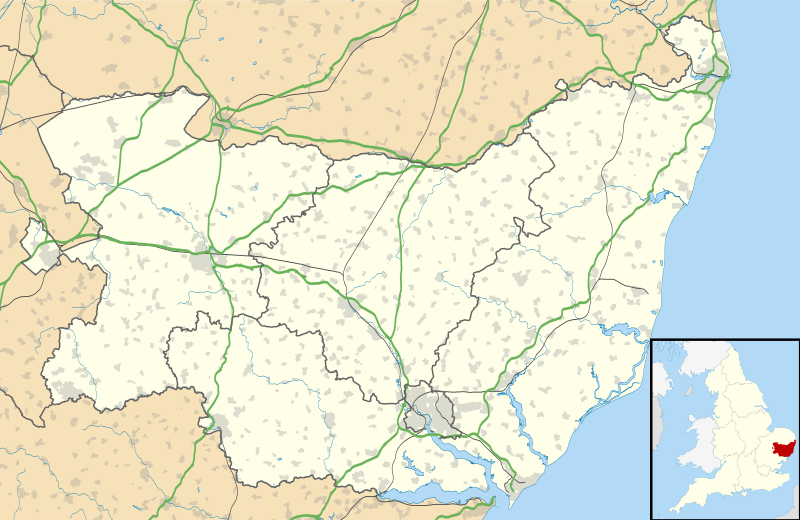 Location in Suffolk | |
| Location | Stowmarket, Suffolk |
| Country | England |
| Denomination | Anglican |
| Website | stowmarketparishchurch |
| History | |
| Status | Parish church |
| Dedication | Saint Peter and Saint Mary |
| Architecture | |
| Functional status | Active |
| Heritage designation | Grade I |
| Architectural type | Norman |
| Administration | |
| Deanery | Stowmarket |
| Archdeaconry | Ipswich |
| Diocese | St Edmundsbury and Ipswich |
| Province | Canterbury |
| Clergy | |
| Vicar(s) | Revd Michael Eden |
| Curate(s) | Revd Richard Stretch |
| Laity | |
| Churchwarden(s) | Rod Lucas, Joan Peachey |
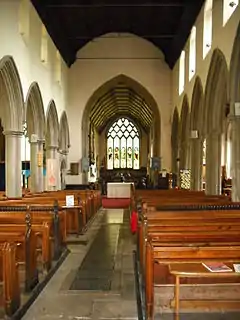
On 28 July 1950 the church was designated a Grade I listed building by English Heritage. The nave, aisles and chancel date from the mid-14th century. The west tower is mid-15th century ("new" in 1453) as are the clerestory and the north and south porches. The spire was re-built in 1712. The church was restored in 1825, a vestry added in 1855, the tower restored in 1894 and the spire removed in 1975.[2] A new spire, with St Peter's keys in gold upon it, was added in 1994 [3]
History
Origins
The Domesday Book indicates a population of 650 for Thorney (Thorney Island) - the original name for Stowmarket, and refers to a "mother church", "a chapel" and "a market". It is likely that the mother church was an Anglo Saxon Minster church, with several clergy. This notion is supported by the large endowment of glebeland, 120 acres (49 ha), which supported the clergy. The Domesday book also mentions "the church at Stow" in the entry for nearby Onehouse.[1]
The entry for Thorney records that 23 of the 120 acres ".. belong to a certain chapel which four brothers, freemen of Hugh de Montford [Lord of Haughey] built on land of their own beside the cemetery of the mother church and they were inhabitants of the parish of the mother church and built this chapel because it could not take the whole parish." It is shown, in later wills, that the mother church of St Peter served the area of Thorney, which comprised the Stowupland end of the parish, Stowupland itself and Gipping. The chapel of St Mary served the inhabitants of the town itself.[1]
15th century to 18th century
By the 1460s the church had become St Peter and St Paul. St Mary's, which stood to the south-east of St Peter's was demolished in about 1546. The dedication of the parish church then became St Peter and St Mary. From about 1120 until the Dissolution in 1539, the Patrons and Rectors of the church were the Augustinian Abbey of St Osyth in St Osyth, Essex. This is the reason why, since 1120, the incumbent has been a vicar.[1]
After 1539 the Patrons were Lay Rectors who could earn an income from the major parish tithes. The upkeep of the chancel was the responsibility of the Rector and Patron. The parishioners were responsible for the upkeep of the remainder of the building, under the supervision of the churchwardens.[1]
Between 1628 and 1655 Thomas Young was vicar of St Peter and St Mary's parish and his portrait hangs on the south wall of the church nave.[1]
After 1800
The church was also the parish church for Stowupland until 1843, when a new district church was built there. Gipping remained a chapel to Stowmarket until 1968 when it was linked with Old Newton. Burials continued at Stowmarket, however, as the churchyard at Gipping was never consecrated. The owners of Gipping had their own chapel and burial vault at the east end of the north aisle until 1891 - which is why all the Tyrell monuments are at Stowmarket.[1] The Tyrells owned Gipping Hall for about 450 years, being a branch of the family of Tyrell of Essex, and played a prominent part in the history of the country, as well as of the county.[4]
Exterior
Main church

The church is constructed of flint with ashlar dressings under slate roofs. The four-stage tower has with set-back buttresses and two-light belfry windows. There is a crenellated flushwork parapet. There is a remaining stump of an octagonal copper-clad spire formerly with a balcony.[2]
The south aisle has six bays and is fitted with three-light flowing tracery windows, between stepped buttresses. Outwardly the north aisle had seven bays, because of the addition of the east chapel; its fenestration is similar to the south. There are four-light aisle west windows. Those of the north aisle have three cusped roundels beneath. The clerestory windows are of double cusped lancets. There is a tall crenellated south porch with flushwork arcading and diapering. It has niches left and right. There is a similar north porch. The chancel, with two bays, has three-light 14th-century flowing tracery windows and a five-light reticulated east window.[2]
Tower and spire

The tower and spire date from the 14th century. At ground level there are north and south arches, similar to those at Combs church, built to accommodate religious processions. Probably after the Reformation, the towers were blocked but were re-opened 1865. The external steps were also added at this time. The timbers at the top of the tower have been dated to 1342–63, as have those at the base of the spire. In 1674 the spire, of some 77 feet (23 m), was taken down as unsafe. It was replaced with a new 100 feet (30 m) spire which incorporated a gallery walkway 40 feet (12 m) from the base, but this blew down in 1703. The west end of the nave and the north aisle were damaged in the storm. In 1712 a new spire was built. It was decorated with the Keys of St Peter and with the initials W.K. for the benefactor William Kent of Stowmarket. This was also removed, in 1975, as unsafe. The present spire was erected in memory of Clifford Cook, It was dedicated by Bishop John Dennis on 17 April 1994. The spire, which resembles the one it replaced, was designed by Andrew Anderson and won the King of Prussia Award.[1][5]
On 6 November 2011 the Bishop of Dunwich, Clive Young, dedicated a permanent ramp, new doors and a toilet, at the base of the tower. The main entrance to the church was thus restored to the tower.[1]
Interior
Medieval and Reformation

The chancel is the oldest part of the church, dating from the late 13th century. In the 14th century it was given new windows on the east and at the side. The nave was rebuilt with a north aisle, 4 feet (1.2 m) narrower than the nave. At the west end of the nave a new tower and spire were constructed. The timbers in the tower have been dated, by dendrochronology, to 1350-63 for the top and to 1342-50 for the bottom. This dates the tower to the mid-14th century.[1]
The south aisle, clerestory, nave roof, north and south porches, and north chancel chapel were added in the 15th century. A will of 1442 describes the north porch as "new". The addition of the south aisle also saw the re-setting of the nave south wall doorway and windows into the new aisle wall.
During the Reformation all altars, saint statues and glass or painted images, were removed. On 5 February 1644 the church was visited by Parliamentary Visitor William Dowsing who ordered the breaking down of "70 superstitious pictures and to level the chancel .." Images from the ends of benches were removed, stained glass windows were destroyed and the cross-keys of St Peter were blotted out on the spire. In 1645 some of the vestments and the organ were sold.[1]
By 1811 the Communion Table was raised by two steps and had 17th- or 18th-century rails on three sides. The pulpit was positioned against the second pillar from the east on the south side, a typical 17th-century position. The interior had high box pews. Over the north aisle a gallery covered all but the two eastern bays, and over the south aisle a gallery covered all but the two eastern bays.[1]
Victorian era
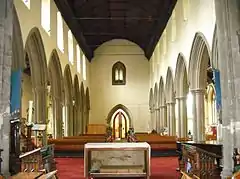
In 1837 uniform box pews were installed in the nave and chancel. The south gallery was extended to the east end and the pulpit, by then three-decker, was relocated to the centre of the nave aisle at the east end. All the changes are shown on an 1843 drawing by Frederick Russell.[6] Across the west end was a deep gallery covering the two western bays of the nave on both sides. This contained the organ, singers and National School children.
In 1856 a major restoration was undertaken by Ipswich architect Richard Phipson, who removed all of the furnishings from the 17th to early-19th century. The pulpit was restored from the three-decker arrangement and was moved to its present position. The nave roof was restored and re-boarded with carved bosses. The church was re-benched and the organ and singers placed in the south aisle. The east and west windows of the south aisle were renewed, together with three of the windows on the south wall. Two of the windows west of the porch, in the Perpendicular style, were replaced with Decorated 14th-century-style windows to match the others. The lean-to roof of the north aisle was replaced with an arch-braced roof. All the windows on the north aisle were restored, with one entirely replaced, by Claxton and Gunn of Stowmarket. The Communion Table was raised. Most of the church floor, including the sanctuary was laid with encaustic tiles by Maw & Co. Gas lighting and underfloor heating were introduced, and in the tower the north and south archways were opened to allow for an entrance porch.[1]
In 1885 Norwich architect Herbert John Green designed a new organ-chamber and choir vestry. This linked the north aisle with the Vestry (now the Parish Office), replacing the aisle east window with an archway and providing a second arch into the chancel for the organ.[1]
Chancel
The chancel shows a lavish use of stone and a high quality of carving and design, especially in the east window. This is accounted for by the patronage of the Abbey of St Osyth. The priest's door on the south, the string course below the window sills and the two shafts which flank the east window all date from about 1280. The earlier windows were replaced in the 14th century with those in a Decorated style, with internal hood moulds. The east window has Decorated reticulated tracery and to the right of the south east window is a crocketted 14th-century shaft. This is all that remains of an elaborate canopy which once stood over a sedilia seat beneath the window.[1]
In the 14th-century north doorway is a 15th-century wooden door with a carved leaf border. The doorway leads to a 15th-century chantry chapel which still has a piscina. On the south side there were also two aumbries (cupboards). There is a stone staircase which lead to a first-floor room - accommodation for the chantry priest. The arch into the organ chamber was built in 1885 as was the choir vestry which is lit by a window to the right.[1]
To the left of the Communion Table, prior to the Reformation, was a large statue of St Peter. The statue, together with a tabernacle, had been built from a 1455 bequest of £6 13s 4d. In 1457 £10 was bequeathed for the construction of a statue of St Mary, which stood to the right of the table. The chancel at that time also contained a statue and tabernacle of the Holy Trinity. On the north wall of the sanctuary was the Easter Sepulcher. Wills of the late 1450s also suggest there was a choir, two choir masters, song books and an organ. In the corner at the north-west is an opening which accessed a loft on top of the rood screen.[1]
The reredos was designed, in 1952, by Munro Cauntley of Ipswich, as were the communion table and rails, They were carved by Edward Barnes of Ipswich, in memory of Mary and George Reeder.[1]
Nave and aisles
In the 14th-century Decorated period, the nave was rebuilt with a new north aisle, a western tower and spire. The night of the nave walls at this time can be seen from the feint horizontal scar above the north arcade, below the clerestory windows. The standard of work in the arcade piers is high and this is reflected in the hood moulds on both the nave and aisle sides of the arches. The piers are similar to those in the churches at Cotton, Orford and Wrentham.[1]
Until 1891 the chapel at the east end of the north aisle was associated with the manorial family at Gipping. Until the late 1430s the Lords of the Manor were the Mountseys. In 1406 Robert Mountsey bequeathed a large sum for the maintenance of his father's tomb, providing firm documentary proof that the north aisle was built in the 14th century. A narrower south aisle was added in the 15th century. The south side arches are taller and the design of the piers, arches, capitals and bases is different. The hood moulds and dripstones with foliage, however, reflect the north arcade. The old doors and windows were reset in the new south wall. Originally the two most westerly windows and the east window were in late 15th-century Perpendicular style, but these were eventually updated, to match the rest in 1865.[1]

The nave walls were heightened on both sides and the above the arcades six clerestory windows were constructed. The south windows are much taller than those on the north. Porches were added to the north and south aisles. The south porch, the grander of the two, has external flushwork decoration, three niches around the entrance, internal blank arcading and a holy water stoup. Above the central niche is a sundial. The north porch is built up against the dripstones of an earlier 14th-century doorway and externally has a niche over the entrance and a holy water stoup to the right.[1]
Wills of some of the parishioners show that, in the medieval period, there were statues or altars to Our Lady of Pity, St Margaret and the Holy Cross. At the east ends both of the aisle chapels had parclose screens around the altars: the north for St Mary and the south for St John the Baptist. Across the chancel arch was a rood screen with painted panels at the base. The open screen was surmounted by a rood loft and above this were figures of the crucified Jesus, with St Mary and St John on either side. Sections of the screen survive today in the font cover and pulpit. In the south-east corner of the north aisle are the original steps to the rood loft, which were blocked during the Reformation and re-discovered only in 1928. An 1843 drawing by Frederick Russell shows five bays of fan vaulting over the chancel arch.[1]
North aisle
The aisle was built in the 14th-century Decorated style, with the door, arched tomb recess and windows all dating from this period. The two eastern bays formed the Gipping Hall chapel where the family vault, last used in 1891, was associated with the Tyrell family. Walter Tirel was allegedly responsible for the death of King William Rufus in 1100. His grandson Hugh Tyrrel took part in the Norman Conquest of Ireland. Sir John Tyrrell fought at the Battle of Agincourt. Sir William Tyrell was killed during the Wars of the Roses and James Tyrrell was the alleged murderer of the Princes in the Tower in 1482. The Gipping Hall chapel is formed by the two eastern bays. Medieval screens to the south and east remained until the 1865 restoration.[1]
There are internal hood moulds and string courses above and below the windows. At the west end the string course is only under the window. There is a trefoil-headed niche in the window jamb to the left of the door. The wooden door is medieval and in the right half has a "wicket gate". The west end of the aisle has three circular seven-foiled windows. Above them is a three-light window with delicate tracery. The three openings were blocked when discovered at the 1865 restoration, when they were unblocked and glazed. It is possible that their original purpose was as a squint to observe Mass celebrated at the North door from the market place, then adjacent to the west end of the church.[1]
Present furnishings
Pulpit and benches
The pulpit is that from the earlier three-decker arrangement, re-located in 1865. It incorporates, in its sides, panels and cresting, used as borders, from the 15th-century rood screen. All of the benches date from 1865, but four traceried bench-ends, with poppy heads, remain, possibly from 1500. The front pair also have arms with animals: a monkey, representing sinfulness, on the south and a lion, representing resurrection, on the north.[1]
Glass
In 1721, when the church was visited by antiquarian Tom Martin, the east window contained medieval glass depicting Adam and Eve being driven out of Paradise. The window was gone by 1756. The side windows had images of St Mary, St John, the death of St Peter and the celebration of the Holy Communion. The remained until the 1865 restoration when they were removed.[1]
The main east window dates from 1875 and 1884 and is by the Camm Brothers, in memory of the Marriott and Oakes families. It replaced a window damaged in the gun cotton explosion of 11 August 1871. The window shows Christ in Majesty flanked by the four Evangelists: Matthew, Mark, Luke and John with their symbols in the tier below. There is also an east window is in memory of Arthur Simpson (d. 1872) who was Sunday School Superintendent. It contains a figure of Charity which may also be by the Camm Brothers.[1]
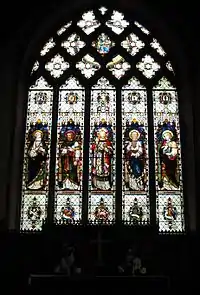
The south-east window was renewed in 1865, with new glass, by Clayton and Bell added in 1878. The window in dedicated to Revd Henry Lewis who was vicar from 1861 to 1867 and who oversaw the 1865 restoration. The images are those of Holy Week. The south-west window was altered in 1909, when the square top was changed to the present Decorated style. The glass shows the Resurrection Angel with a trumpet and is by Arthur Moore & Co. of London. The style is rich Arts and Crafts.[1]
The four south windows, dedicated in 2006, are in memory of Frank Lang (d. 2003) and his wife Hilda (d. 1988), with the western window containing the dove crest of the Lang family. Each has the monogram of the designer Helen Wittaker, the calligrapher Charles Smith and the studio of Keith Barley of Dunnington.[1]
The west window, re-glazed in 1997, has each piece of glass in the tracery inscribed with the names of, or a quotation from, the donors. In the three circular windows the glass was the gift of Stowmarket Rotary Club, the Arbon family and the Mothers' Union.[1]
Monuments
- Under the eastern arch: Margaret Tyrell (née Darcy, d. 1449), wife of William Tyrell of Gipping Hall. Box tomb removed in 1865. Shields above with 12 figures along sides and base. The arch terminates with dripstones carved as dragons and lions.
- East wall, south side: Dame Dorothy Forth (d. 1641). wife of William Tyrell. The couple hold hands over a skull. Below are their three children who all died at an early age. William erected the monument and included himself as there would be none left to put a monument to him.

- East wall, north side: Ann Tyrell (d. 1638) aged 8 years and 6 months.
- East wall, north side, above: Edmund Tyrell (d. 1799), by John de Carle of Norwich.
- North wall: Margaret English (née Tyrell) of Westminster (d. 1604). Margaret herself is shown at the left. Facing her, on the right, are her brother Thomas, sister-in-law Mary, and their ten children.
- East end: Charles Blouse Esq. (d. 1724). An inscription in a n oval cartouche of drapery, surmounted by an urn, with a single angel head beneath.
- West end: Thomas More Gent (d. 1754). A large rectangular monument with a pair of angels at the base.[1]
Portrait and hatchment
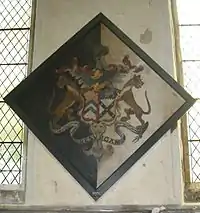
On the south wall of the nave, adjacent to the south porch, hangs a portrait of Revd Dr Thomas Young, tutor to John Milton, who was vicar at the church between 1628 and 1655. A leading Puritan preacher, poet and Master of Jesus College, Cambridge, Young had been tutor to Milton from age 10 to 12. In 1625 and 1628 Milton wrote two letters to Young and in 1627 dedicated a Latin Elegy to him. Milton held Young in great esteem and the 1628 letter indicates that he intended to visit Young at Stowmarket. This brief mention, however, is the only evidence that Milton may have visited the town.[1]
The hatchment has the Tyrell Baker coat of arms and commemorates the 1774 marriage of Revd Charles Tyrell and Elizabeth, daughter of Edmund Baker. Charles, who was owner of Gipping Hall and Rector of Thurston, died in 1811. His half of the hatchment is thus black and that of his wife, who survived him, is white.[1]
Font and South aisle
The font is Victorian, but the wooden cover incorporates a 15th-century carved poppy head as a finial and parts of a screen around the edges. Near to the font is a 13th-century stone coffin lid, with a raised cross, that was found in the churchyard.
The reredos to the War Memorial Chapel in the south aisle, is by Eleanor Gribble of Ipswich, in a pre-Raphaelite style using medieval gesso techniques. The centre panel shows the Adoration of the Magi, on the outer panels are the angels of Self-Sacrifice, Fortitude, Victory and Peace.[1]
Organ

The three-manual organ was made by Hele & Co in 1901 for Emmanuel Church, Paddington. In 1973 it was rebuilt and was moved to Stowmarket in 1993 by Bishop and Sons. It is a memorial to Hilda Margaret Lang, by her family.[1]
Administration
The vicar is the Revd Michael Eden and the curate is the Revd Richard Stretch. Alan Lancaster and Tony Ingham are both readers. Marion Gray is churchwarden. The Secretary role is unfilled and the Treasurer is Geoff Marchant.[7] St Peter and St Mary's Church is the parish church of Stowmarket and is part of the Church of England in the Diocese of St Edmundsbury and Ipswich in Suffolk.
Bells
The tower houses a peal of eight bells, with dates ranging from c.1460 to 1823. The oldest bell, the 8 cw 4th, is probably by John Danyell of London and is from about 1460; the 8th is by Miles Gray of Colchester 1622; the 7th and 3rd are by John Darby of Ipswich 1672 and 1691 respectively; the 5th is by Charles Newman of King's Lynn 1699; the 2nd by Thomas Osbourne of Downham Market 1791; the 1st is by William Dobson of Downham Market 1810; the 6th is by Thomas Mears of London 1823. The total weight of the eight bells is 4.5 tons.[1]
In 1894 the bells were restored by Bowell & Son, when they were taken from the tower and transported to Ipswich by horse and cart and then by barge on the River Gipping. The new oak frame that was re-fitted remains today. The fittings were completely restored in 1966 and three of the bells were recast.[1]
The ringer chamber in the tower contains a "gotch", dated 1780. This wicker-covered ale jug was originally used to supply 4.5 imperial gallons (20 l) of ale, as payment to the bell ringers.[1]
References
- Paine, C. St Peter and St Mary's Church, Stowmarket, Official Church Guide, St Peter and St Mary's Church, Stowmarket
- Good Stuff (28 July 1950). "Church of St Peter and St Mary - Stowmarket - Suffolk - England". British Listed Buildings. Retrieved 25 May 2015.
- "Stock Photo - Church of St Peter & St Mary, Stowmarket, Suffolk, UK. The modern spire added in 1994". Alamy Ltd.
- "History - St Peter and St Marys Church of England". Stowmarketparishchurch.co.uk. Retrieved 31 May 2015.
- "2015 Architecture Awards". National Churches Trust. Retrieved 7 July 2015.
- "Suffolk Painters". Suffolk Painters. Retrieved 31 May 2015.
- "Who is Who". stowmarketparishchurch.co.uk. Retrieved 13 June 2018.
Bibliography
- David Lillistone, D. (1999), The Lady and the Abbot's Tomb in the Church of St Peter and St Mary, Stowmarket, Suffolk
- Hollingsworth, A. G. H. (1844), The History of Stowmarket: the ancient county town of Suffolk, with some notices of the hundred of Stow, compiled in a popular form from Doomsday-book --M.S.S. in the British Museum--parish papers in Stow Church chests, &c. -- and connected with the history of the county
External links
| Wikimedia Commons has media related to St Peter and St Mary, Stowmarket. |
- St Peter and St Mary, Stowmarket at suffolkchurches.co.uk
